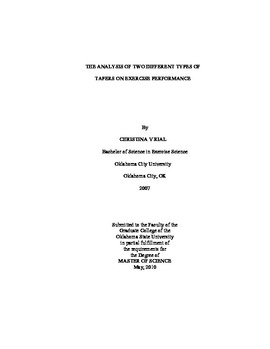| dc.contributor.advisor | Smith, Douglas B. | |
| dc.contributor.author | Rial, Christina V | |
| dc.date.accessioned | 2014-04-16T03:11:52Z | |
| dc.date.available | 2014-04-16T03:11:52Z | |
| dc.date.issued | 2010-05-01 | |
| dc.identifier.uri | https://hdl.handle.net/11244/9787 | |
| dc.description.abstract | Athletes depend on tapers to allow repair and rest for the individual prior to competition. Many variables affect the performance of a taper. These variables include volume, intensity, duration, frequency, and the type of taper. The type of taper may include a step taper, progressive taper, or exponential decay taper. Manipulation of these variables may be the best accommodation for the athlete. The purpose of this study is to compare the differences in a step taper and an exponential decay taper across time. The variables that are statistically studied are heart rate, rate of perceived exertion, and VO2 max at the pre-test and post-test periods. Method: Nineteen subjects volunteered and participated in the study (age 24 11.04 years). The subjects were divided into two groups; the step taper group (n=8) and the exponential decay taper group (n=11). The participant's baseline tested, trained for a middle-distance run for 4 weeks, and pre-tested. The participants were then randomly assigned to one of the groups and performed the one week designated taper. Following the taper was a post-test period. Findings: There was a significant difference in stage 4 (Brue Protocol Test) in the pre-test and stage2 in the post-test periods for RPE comparisons(p ≤ .05). There was also a significant difference in stages 1 and 2 of the pre-test in regards to submax HR values. VO₂ max values did not show any statistical significance across time. According to this study, the statistics show there is no significant benefit to either taper. Conclusion: In previous research, there has been evidence that an exponential decay taper is more beneficial to a step taper. More research should be analyzed to compare the variables. It is recommended that the study be conducted over a longer period with multiple trials. The study should be conducted in a real setting rather than a clinical one. The taper should also compare more than one endurance event such as swimming, running , and cycling. An increase in participant numbers would produce a better reliability of the athletic population. | |
| dc.format | application/pdf | |
| dc.language | en_US | |
| dc.publisher | Oklahoma State University | |
| dc.rights | Copyright is held by the author who has granted the Oklahoma State University Library the non-exclusive right to share this material in its institutional repository. Contact Digital Library Services at lib-dls@okstate.edu or 405-744-9161 for the permission policy on the use, reproduction or distribution of this material. | |
| dc.title | Analysis of Two Different Types of Tapers on Exercise Performance | |
| dc.type | text | |
| dc.contributor.committeeMember | Warren, Aric | |
| dc.contributor.committeeMember | Edwards, Steve | |
| osu.filename | Rial_okstate_0664M_10873.pdf | |
| osu.college | Education | |
| osu.accesstype | Open Access | |
| dc.description.department | School of Teaching and Curriculum Leadership | |
| dc.type.genre | Thesis | |
| dc.subject.keywords | exercise | |
| dc.subject.keywords | exponential decay | |
| dc.subject.keywords | performance | |
| dc.subject.keywords | step | |
| dc.subject.keywords | taper | |
| dc.subject.keywords | vo2 max | |
